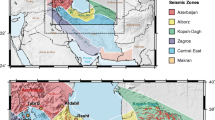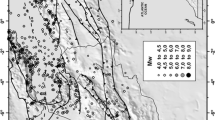Abstract
The Gulf of Aden is one of the active tectonic elements encompassing the Arabian Plate, representing a potential hazard for the southern parts of Oman and Yemen. This calls for an improved seismic source model for the Gulf, which is crucial for any future seismic hazard assessment regardless of the adopted approach. The developed model is delineated based on a statistical analysis of an updated earthquake catalogue, tectonic setting, and stress regime in the Gulf of Aden. Kernel density estimation (KDE) is applied to obtain an approximation of the probability density function that governs the statistical distribution of earthquakes in the area. The spatial distribution of earthquake and seismic moment kernel densities are calculated to contribute to the modeling of the seismic source. Statistical methods were then applied for estimating the maximum possible earthquake magnitude (Mmax) and the earthquake recurrence parameters [annual rate of earthquakes (λ) and β-value] for each delineated seismic zone. The seismotectonic features and the results of statistical analysis led to the delineation of four seismic sources with their essential parameters to produce a more reliable seismic hazard analysis.













Similar content being viewed by others
Data availability
The utilized data that used in the current research are available upon request.
References
Al-Arifi, N. S., Fat-Helbary, R. E., Khalil, A. R., & Lashin, A. A. (2013). A new evaluation of seismic hazard for the northwestern part of Saudi Arabia. Natural Hazards, 69, 1435–1457.
Alrubaidi, M., Alhaddad, M. S., Al-Safi, S. I. H., Alhammadi, S. A., Yahya, A. S., & Abadel, A. A. (2021). Assessment of seismic hazards in Yemen. Heliyon., 7, e08520.
Al-Shijbi, Y., Deif, A., El-Hussain, I., Mohamed, A. M. E., & Al-Dairi, A. (2019). Deaggregation of probabilistic seismic hazard for selected cities in the Arabian Peninsula. Arab Journal of Geosciences, 12, 518.
Angelier, J. (1979). Determination of the mean principal directions of stresses for a given fault population. Tectonophysics, 56, T17–T26.
Angelier, J. (1984). Tectonic analysis of fault slip data sets. Journal of Geophysical Research, 89, 5835–5848.
Angelier, J., & Mechler, P. (1977). Su rune methode graphique de recherché des contraintes principales egalement ultilisable en tectonique et en seismologie: La methode des diedres droits (pp. 651–652). XIX: Bulletin de la Société Géologique de France.
Angelier, J., Slunga, R., Bergerat, F., Stefansson, R., & Homberg, C. (2004). Perturbation of stress and Oceanic rift extension across transform faults shown by earthquake focal mechanism in Iceland. Earth and Plant. Sci. Let., 219, 27–284.
Armijo, R., Carey, E., & Cisternas, A. (1982). The inverse problem in microtectonics and the separation of tectonic phases. Tectonophysics, 82, 145–160.
ArRajehi, A., McClusky, S., Reilinger, R., Daoud, M., Alchalbi, A., Ergintav, S., Gomez, F., Sholan, J., Bou-Rabee, F., Ogubazghi, G., Haileab, B., Fisseha, S., Asfaw, L., Mahmoud, S., Rayan, A., Bendik, R., & Kogan, L. (2010). Geodetic constraints on present-day motion of the Arabian Plate: Implications for Red Sea and Gulf of Aden rifting. Tectonics, 29, TC3011.
Babiker, N., Mula, A., & El-Hadidy, S. (2015). A unified Mw-based earthquake catalogue and seismic source zones for the Red Sea. Journal of African Earth Sciences, 109, 168–176.
Bosworth, W., Huchon, P., & McClay, K. (2005). The red sea and Gulf of Aden basins. Journal of African Earth Sciences, 43, 334–378.
Bott, M. H. P. (1959). The mechanics of oblique slip faulting. Geology Magazine, 96, 1.
Burkhard, M., & Grünthal, G. (2009). Seismic source zone characterization for the seismic hazard assessment project PEGASOS by the Expert Group 2 (EG 1 b). Swiss Journal of Geosciences, 102, 149–188.
Chen, Y. C. (2017). A tutorial on kernel density estimation and recent advances. Biostatistics and Epidemiology, 1, 161–187.
Cornell, CA., Vanmarcke, EH. (1969). The major influences on seismic risk. In: Proceedings of the fourth world conference of earthquake engineering, 1, Santiago, Chile, p 69–83
D’Acremont, E., Leroy, S., Beslier, M., Bellahsen, N., Fournier, M., Robin, C., Maia, M., & Gente, P. (2005). Structure and evolution of the eastern Gulf of Aden conjugate margins from seismic reflection data. Geophysical Journal International, 160, 869–890.
Deif, A., Al-Shijbi, Y., El-Hussain, I., Ezzelarab, M., & Mohamed, A. M. E. (2017). Compiling an earthquake catalogue for the Arabian Plate, Western Asia. Journal of Asian Earth Sciences, 147, 345–357.
Delvaux, D., & Sperner, B. (2003). New aspects of tectonic stress inversion with reference to the TENSOR program. Geological Society, London, Special Publications, 212, 75–100.
El-Hussain, I., Al-Shijbi, Y., Deif, A., Mohamed, A. M. E., & Ezzelarab, M. (2018). Developing a seismic source model for the Arabian Plate. Arabian Journal of Geosciences, 11, 435.
El-Hussain, I., Deif, A., Al-Jabri, K., Toksoz, N., El-Hady, S., Al-Hashmi, S., Al-Toubi, K., Al-Shijbi, Y., Al-saifi, M., & Kuleli, S. (2012). Probabilistic seismic hazard maps for Sultanate of Oman. Natural Hazards, 64, 173–210.
Etchecopar, A., Vasseur, G., & Daignieres, M. (1981). An inverse problem in microtectonics for the determination of stress tensors from fault striation analysis. Journal of Structural Geology, 3, 51–65.
Gutenberg, B., & Richter, C. F. (1941). Seismicity of the Earth (p. 34). Geological Society of America.
Gutenberg, B., & Richter, C. F. (1944). Frequency of earthquakes in California. Bulletin of the Seismological Society of America, 34, 185–188.
Hanks, T. C., & Kanamori, H. (1979). A moment magnitude scale. Journal of Geophysical Research, 84, 2348–2350.
Kijko, A. (2004). Estimation of the maximum earthquake magnitude Mmax. Pure and Applied Geophysics, 161, 1655–2168.
Kijko, A., & Sellevoll, M. A. (1992). Estimation of earthquake hazard parameters from incomplete data files, part II. Bulletin of the Seismological Society of America, 82, 120–134.
Kijko, A., & Singh, M. (2011). Statistical tools for maximum possible earthquake magnitude estimation. Acta Geophysica, 59, 674–700.
Leroy, S., Autin, J., Bache, F., D’Acremont, E., Watremez, L., Robinet, J., Baurion, C., Denele, Y., Bellahsen, N., Lucazeau, F., Rolandone, F., Rouzo, S., Kiel, J., Robin, C., Guillocheau, F., Tiberi, C., Basuyau, C., Beslier, M.-O., & Al-lazki, A. (2012). From rifting to oceanic spreading in the Gulf of Aden: A synthesis. Arabian Journal of Geosciences, 5, 859–901.
McKenzie, D. P. (1969). The relation between fault plane solutions for earthquakes and the directions of principal stresses. Bulletin of the Seismological Society of America, 59, 591–601.
Mohindra, R., Nair, A. S., Gupta, S., Sur, U., & Sokolov, V. (2012). Probabilistic seismic hazard analysis for Yemen. International Journal of Geophysics, 2012, 304235.
Pascucci, V., Free, M.W., Lubkowski, Z.A. (2008). Seismic hazard and design requirements for the Arabian Peninsula region. In: Proceedings of the 14th world conference on earthquake engineering, Beijing, China 12–17
Sahota G. (1990). Geophysical investigations of the Gulf of Aden continental margins: geodynamic implications for the development of the Afro-Arabian rift system, PhD thesis, University College, London
Sharon, M., Sagy, A., Kurzon, I., Marco, S., & Rosensaft, M. (2020). Assessment of seismic sources and capable faults through hierarchic tectonic criteria: Implications for seismic hazard in the Levant. Natural Hazards and Earth System Sciences, 20, 125–148.
Uhrhammer, R. (1986). Characteristics of Northern and Central California Seismicity. Earthquake Notes, 57(1), 219.
Vermeulen, P., & Kijko, A. (2017). More statistical tools for maximum possible earthquake magnitude estimation. Acta Geophysica, 65, 579–587.
Wallace, R. E. (1951). Geometry of shearing stress and relation to faulting. Journal of Geology, 59, 118–130.
Wells, D. L., & Coppersmith, K. J. (1994). New empirical relationships among magnitude, rupture length, rupture width, rupture area, and surface displacement. Bulletin of Seismological Society of America, 84, 974–1002.
Zahran, H. M., Sokolov, V., El-Hadidy, S., & Alradadi, W. W. (2015). Preliminary probabilistic seismic hazard assessment for the Kingdom of Saudi Arabia based on combined areal source model: Monte Carlo approach and sensitivity analyses. Soil Dynamics and Earthquake Engineering, 77, 453–468.
Funding
The authors declare that no funds, grants, or other support was received during the preparation of this manuscript.
Author information
Authors and Affiliations
Contributions
AD: conceptualization; methodology; writing; original draft preparation; supervision. AMEM: conceptualization; data curation; methodology; supervision; writing; editing and review. IEH: conceptualization; research administration supervision; validation; and review. YAS: conceptualization; formal analysis; and review. EAAN: conceptualization; formal analysis; and review. IEH, HAK: conceptualization; formal analysis. All authors have approved the final article.
Corresponding author
Ethics declarations
Conflict of Interest
The authors have no relevant financial or non-financial interests to disclose.
Additional information
Publisher's Note
Springer Nature remains neutral with regard to jurisdictional claims in published maps and institutional affiliations.
Rights and permissions
Springer Nature or its licensor (e.g. a society or other partner) holds exclusive rights to this article under a publishing agreement with the author(s) or other rightsholder(s); author self-archiving of the accepted manuscript version of this article is solely governed by the terms of such publishing agreement and applicable law.
About this article
Cite this article
Deif, A., Al Kubaisy, H., Abu El-Nader, I.F. et al. Characterization of Seismic Source Zones in the Gulf of Aden Region. Pure Appl. Geophys. 180, 91–110 (2023). https://doi.org/10.1007/s00024-022-03219-1
Received:
Revised:
Accepted:
Published:
Issue Date:
DOI: https://doi.org/10.1007/s00024-022-03219-1




